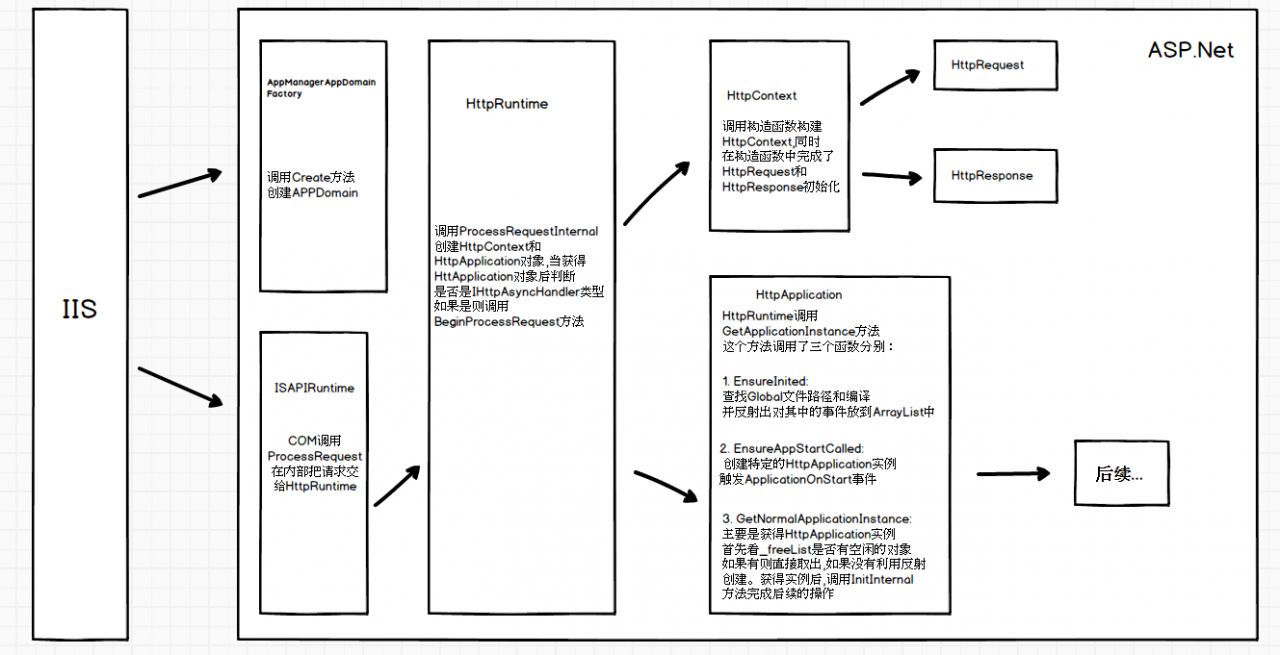上面两篇文章说了http协议和IIS处理,这次说下当IIS把请求交给Asp.net后的过程。
AppManagerAppDomainFactory
-
当IIS把请求交给asp.net时候,如果AppDomain还不存在则创建APPDomain,将AppDomain指派给与请求对应的应用程序,这通过AppManagerAppDomainFactory类中的Create方法实现,代码如下:
public Object Create(String appId, String appPath) { try { if (appPath[0] == '.') { System.IO.FileInfo file = new System.IO.FileInfo(appPath); appPath = file.FullName; } if (!StringUtil.StringEndsWith(appPath, '\\')) { appPath = appPath + "\\"; } ... ISAPIApplicationHost appHost = new ISAPIApplicationHost(appId, appPath,false); //创建环境,包括编译环境 ISAPIRuntime isapiRuntime = (ISAPIRuntime)_appManager.CreateObjectInternal(appId, typeof(ISAPIRuntime), appHost, false, null); isapiRuntime.StartProcessing(); return new ObjectHandle(isapiRuntime); } catch (Exception e) { ... } } -
创建完成后,非托管代码开始调用 ISAPIRuntime 中ProcessRequest方法(通过COM调用 )
ISAPIRuntime–asp.net入口
-
首先看下ISAPIRuntime中的ProcessRequest方法签名
public int ProcessRequest(IntPtr ecb, int iWRType); -
ProcessRequest有两个参数,一个是请求报文的ecb句柄,一个请求的类型,在运行的过程中,ecb首先被再次封装成托管资源的请求报文wr。 把封装好的代码传递给HttpRuntime类中的ProcessRequestNoDemand. 核心代码如下:
bool useOOP = (iWRType == WORKER_REQUEST_TYPE_OOP); wr = ISAPIWorkerRequest.CreateWorkerRequest(ecb, useOOP); wr.Initialize(); // check if app path matches (need to restart app domain?) String wrPath = wr.GetAppPathTranslated(); String adPath = HttpRuntime.AppDomainAppPathInternal; if (adPath == null || StringUtil.EqualsIgnoreCase(wrPath, adPath)) { HttpRuntime.ProcessRequestNoDemand(wr); return 0; } else { // need to restart app domain HttpRuntime.ShutdownAppDomain(ApplicationShutdownReason.PhysicalApplicationPathChanged, SR.GetString(SR.Hosting_Phys_Path_Changed, adPath, wrPath)); return 1; }
HttpRuntime
-
HttpRuntime收到传递过来的HttpWorkerRequest类的实例对象wr,通过调用当前类中的ProcessRequestNow方法,把参数传递给ProcessRequestInternal(ProcessRequestNow的调用了ProcessRequestInternal)。
internal static void ProcessRequestNoDemand(HttpWorkerRequest wr) { RequestQueue rq = _theRuntime._requestQueue; wr.UpdateInitialCounters(); if (rq != null) // could be null before first request wr = rq.GetRequestToExecute(wr); if (wr != null) { CalculateWaitTimeAndUpdatePerfCounter(wr); wr.ResetStartTime(); ProcessRequestNow(wr); } } internal static void ProcessRequestNow(HttpWorkerRequest wr) { _theRuntime.ProcessRequestInternal(wr); } -
在ProcessRequestInternal中,创建了HttpContext和HttpApplication对象实例,核心代码如下
private void ProcessRequestInternal(HttpWorkerRequest wr) { ... // Construct the Context on HttpWorkerRequest, hook everything together HttpContext context; try { context = new HttpContext(wr, false /* initResponseWriter */); } catch { ... } ... try { ... // Get application instance IHttpHandler app = HttpApplicationFactory.GetApplicationInstance(context); if (app == null) throw new HttpException(SR.GetString(SR.Unable_create_app_object)); ... if (app is IHttpAsyncHandler) { // asynchronous handler IHttpAsyncHandler asyncHandler = (IHttpAsyncHandler)app; context.AsyncAppHandler = asyncHandler; asyncHandler.BeginProcessRequest(context, _handlerCompletionCallback, context); } else { // synchronous handler app.ProcessRequest(context); FinishRequest(context.WorkerRequest, context, null); } } catch (Exception e) { ... } } -
在ProcessRequestInternal方法的内部,实现对HttpContext类和HttpApplicationFactory的对象实例的创建,核心代码: 根据上面代码,当获得HttApplication对象后,判断是否是IHttpAsyncHandler类型,如果是则调用BeginProcessRequest方法,此处的if条件是一直成立的,因为HttpApplication实现了IHttpAsyncHandler接口,而ProcessRequest方法的实现也仅仅是抛出了一个异常,笔者觉得此处应该是微软留了一个扩展的地方。
public class HttpApplication:IComponent,IHttpAsyncHandler, IRequestCompletedNotifier, ISyncContext { ... }void IHttpHandler.ProcessRequest(HttpContext context) { throw new HttpException(SR.GetString(SR.Sync_not_supported)); }
HttpContext对象
这个对象是一个请求响应的结合体,里面包含了HttpRequest和HttpResponse对象,在构造HttpContext对象时,同时也对HttpRequest和HttpResponse也进行了初始化,代码如下:
internal HttpContext(HttpWorkerRequest wr, bool initResponseWriter) {
_wr = wr;
Init(new HttpRequest(wr, this), new HttpResponse(wr, this));
if (initResponseWriter)
_response.InitResponseWriter();
PerfCounters.IncrementCounter(AppPerfCounter.REQUESTS_EXECUTING);
}创建HttpApplication
通过HttpApplicationFactory中的静态方法GetApplicationInstance来获得实例对象(常用的工厂模式),在创建对象的时候调用了 _theApplicationFactory.GetNormalApplicationInstance(context);方法(其中context形参是上文创建的HttpContext)来执行实例化操作,核心代码如下:
internal static IHttpHandler GetApplicationInstance(HttpContext context) {
if (_customApplication != null)
return _customApplication;
// Check to see if it's a debug auto-attach request
if (context.Request.IsDebuggingRequest)
return new HttpDebugHandler();
_theApplicationFactory.EnsureInited();
_theApplicationFactory.EnsureAppStartCalled(context);
return _theApplicationFactory.GetNormalApplicationInstance(context);
}
这个方法里有三个方法的调用,分别是:
i. _theApplicationFactory.EnsureInited()
主要功能是对Global.asxc文件进行编译和处理,并反射出对其中的事件,放到ArrayList中,核心代码如下:
-
找到global.asax路径进行编译
private void Init() { if (_customApplication != null) return; try { try { _appFilename = GetApplicationFile(); CompileApplication(); } finally { SetupChangesMonitor(); } } catch { throw; } } -
调用ReflectOnApplicationType方法把事件装入ArrayList
private void CompileApplication() {
_theApplicationType = BuildManager.GetGlobalAsaxType();
BuildResultCompiledGlobalAsaxType result = BuildManager.GetGlobalAsaxBuildResult();
if (result != null) {
if (result.HasAppOrSessionObjects) {
GetAppStateByParsingGlobalAsax();
}
_fileDependencies = result.VirtualPathDependencies;
}
if (_state == null) {
_state = new HttpApplicationState();
}
ReflectOnApplicationType();
}
private void ReflectOnApplicationType() {
ArrayList handlers = new ArrayList();
MethodInfo[] methods;
// get this class methods
methods = _theApplicationType.GetMethods(BindingFlags.NonPublic | BindingFlags.Public | BindingFlags.Instance | BindingFlags.Static);
foreach (MethodInfo m in methods) {
if (ReflectOnMethodInfoIfItLooksLikeEventHandler(m))
handlers.Add(m);
}
Type baseType = _theApplicationType.BaseType;
if (baseType != null && baseType != typeof(HttpApplication)) {
methods = baseType.GetMethods(BindingFlags.NonPublic | BindingFlags.Instance | BindingFlags.Static);
foreach (MethodInfo m in methods) {
if (m.IsPrivate && ReflectOnMethodInfoIfItLooksLikeEventHandler(m))
handlers.Add(m);
}
}
_eventHandlerMethods = new MethodInfo[handlers.Count];
for (int i = 0; i < _eventHandlerMethods.Length; i++)
_eventHandlerMethods[i] = (MethodInfo)handlers[i];
}ii. _theApplicationFactory.EnsureAppStartCalled(context)
创建特定的HttpApplication实例,触发ApplicationOnStart事件,执行ASP.global_asax中的Application_Start(object sender, EventArgs e)方法。这里创建的HttpApplication实例在处理完事件后,就被回收。 具体实现:
private void EnsureAppStartCalled(HttpContext context) {
if (!_appOnStartCalled) {
lock (this) {
if (!_appOnStartCalled) {
using (new DisposableHttpContextWrapper(context)) {
// impersonation could be required (UNC share or app credentials)
WebBaseEvent.RaiseSystemEvent(this, WebEventCodes.ApplicationStart);
// fire outside of impersonation as HttpApplication logic takes
// care of impersonation by itself
FireApplicationOnStart(context);
}
_appOnStartCalled = true;
}
}
}
} iii. _theApplicationFactory.GetNormalApplicationInstance(context);
主要是获得HttpApplication实例,首先从队列中去取,如果取出为空,则利用反射创建,调用InitInternal方法
private HttpApplication GetNormalApplicationInstance(HttpContext context) {
HttpApplication app = null;
lock (_freeList) {
if (_numFreeAppInstances > 0) {
app = (HttpApplication)_freeList.Pop();
_numFreeAppInstances--;
if (_numFreeAppInstances < _minFreeAppInstances) {
_minFreeAppInstances = _numFreeAppInstances;
}
}
}
if (app == null) {
// If ran out of instances, create a new one
app = (HttpApplication)HttpRuntime.CreateNonPublicInstance(_theApplicationType);
using (new ApplicationImpersonationContext()) {
// 调用BuildSteps和获得所有的HttpModule
app.InitInternal(context, _state, _eventHandlerMethods);
}
}
if (AppSettings.UseTaskFriendlySynchronizationContext) {
// When this HttpApplication instance is no longer in use, recycle it.
app.ApplicationInstanceConsumersCounter = new CountdownTask(1); // representing required call to HttpApplication.ReleaseAppInstance
app.ApplicationInstanceConsumersCounter.Task.ContinueWith((_, o) => RecycleApplicationInstance((HttpApplication)o), app, TaskContinuationOptions.ExecuteSynchronously);
}
return app;
}
从代码中可以分析到,在HttpApplication创建的过程中,是有一个_freeList的一个堆栈来控制的。当对象创建成功后,执行app.InitInternal(context, _state, _eventHandlerMethods)来进行后续的操作。整个的代码流程,可以理解成以下过程:

源码git地址:https://github.com/fuwei199006/Source/tree/master/dotnet46/Source
写于 2017.03.07